We keep coming back to this square, the Westermarkt – not just because it’s beautiful (it is), but because it holds a powerful truth: we are standing on the shoulders of heroes. Every visit to the Homomonument reminds us of the LGBTQ+ activists who fought before us so that we could love, gather, and be visible today. Located in the heart of Amsterdam, next to the historic Westerkerk and just steps from the Anne Frank House, the Homomonument and Pink Point hold significant importance for queer travelers, allies, and locals alike. As WorldPride 2026 in Amsterdam approaches, we would like to introduce you to this special safe space in Amsterdam, which symbolically blends remembrance, resilience, and celebration in the queer heart of the Dutch capital.

What is the Homomonument in Amsterdam?
Inaugurated on 5 September 1987, the Homomonument is the first memorial in the world dedicated to LGBTQ+ people persecuted for who they are. Artist Karin Daan designed it as a large pink granite triangle. Embedded in the pavement, with three points symbolically facing the Anne Frank House (standing for the past), the Dam Square/National Monument (representing the present), and the LGBTQ+ community center COC (symbol for the future). Each direction represents a different dimension of queer memory and resistance: the past, present, and future.
History detour: Did you know that the pink triangle was a Nazi badge given to queer prisoners in the concentration camps of the Third Reich? Today, the queer community reclaimed the badge, a symbol of LGBTQ+ resistance.
Key features of the Homomonument
- Inaugurated: 5 September 1987
- Designer: Karin Daan
- Shape: Pink triangle
- Symbolism: Past (Anne Frank House), Present (Parliament), Future (COC)
Its creation was driven by a grassroots movement in the 1970s and 80s, a time when public queer visibility was still met with strong resistance. The monument invites us to gather, resist, and heal together. Whether during a protest, a memorial, or a quiet moment at dusk, the Homomonument remains a living symbol of resilience and strength. It reminds all who visit that queer history is not only a story of struggle but also one of courage, solidarity, and enduring pride.
Advertisement
KLM Flight Deals
Fly around the world with our gay-friendly partner KLM Royal Dutch Airlines, and its partners Air France and Delta Air Lines in Economy, Premium Comfort and Business Class to LGBTQ+ welcoming destinations worldwide.
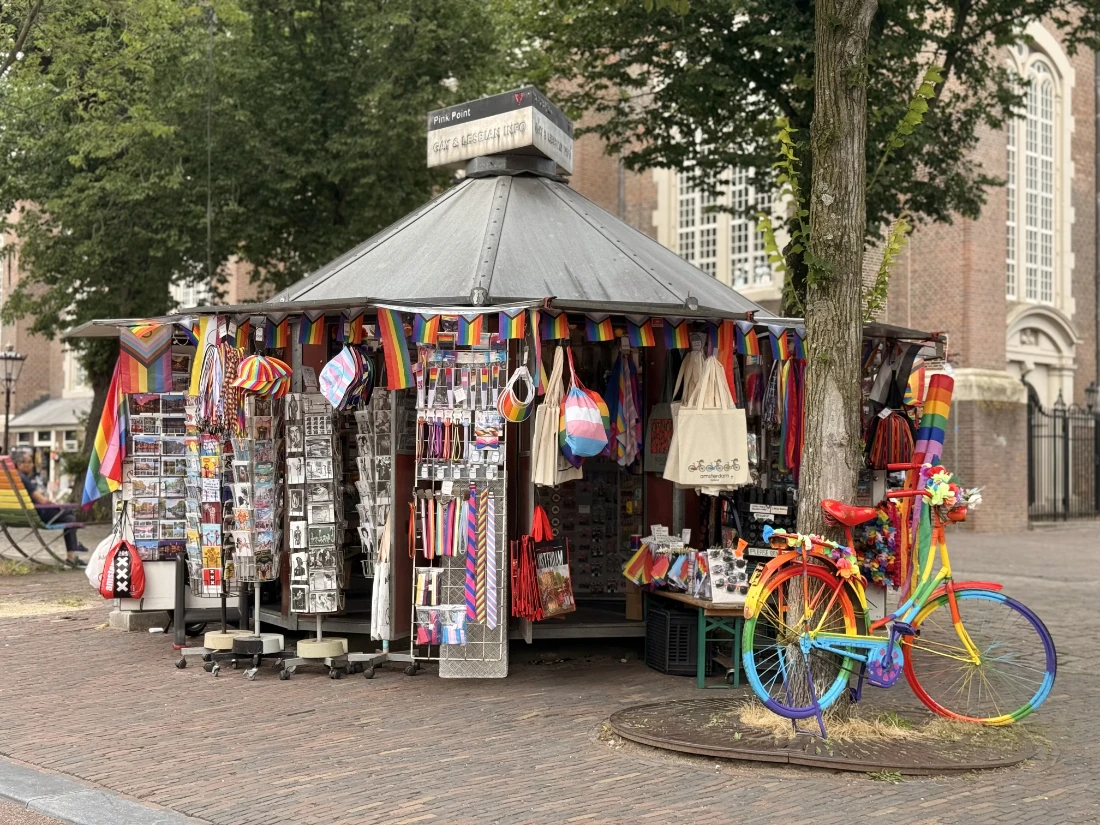
Pink Point: Amsterdam’s LGBTQ+ info hub & queer installation
Right beside the Homomonument stands Pink Point Amsterdam, a small but powerful kiosk that serves as the official information center for LGBTQ+ travelers and locals. Since 1998, it has offered free maps, helpful safety tips, and queer-focused travel advice. But Pink Point is more than just a kiosk – it’s a beacon of visibility and a connection point for queer people from all over the world. It offers a curated selection of merchandise, including Pride flags, postcards, buttons, and the popular porcelain figurines of two kissing little individuals of the same gender from the Netherlands.
What you can find at Pink Point
- Free LGBTQ+ maps and guides
- Safety and Pride event information
- Queer souvenirs: postcards, flags, buttons
- Iconic gifts: porcelain kissing Dutch figurines
- Owner Stefaan can give you his local insights
For us, this place holds personal meaning. Back then, shortly after his coming out, when Karl was working at Gerede e.V. in Dresden, he dreamt of creating a Pink Point-like space for his community. Although that dream never came to life in that form, his work there helped build a similar foundation of support. Today, we visit Pink Point not just as tourists but as grateful members of a global queer family.
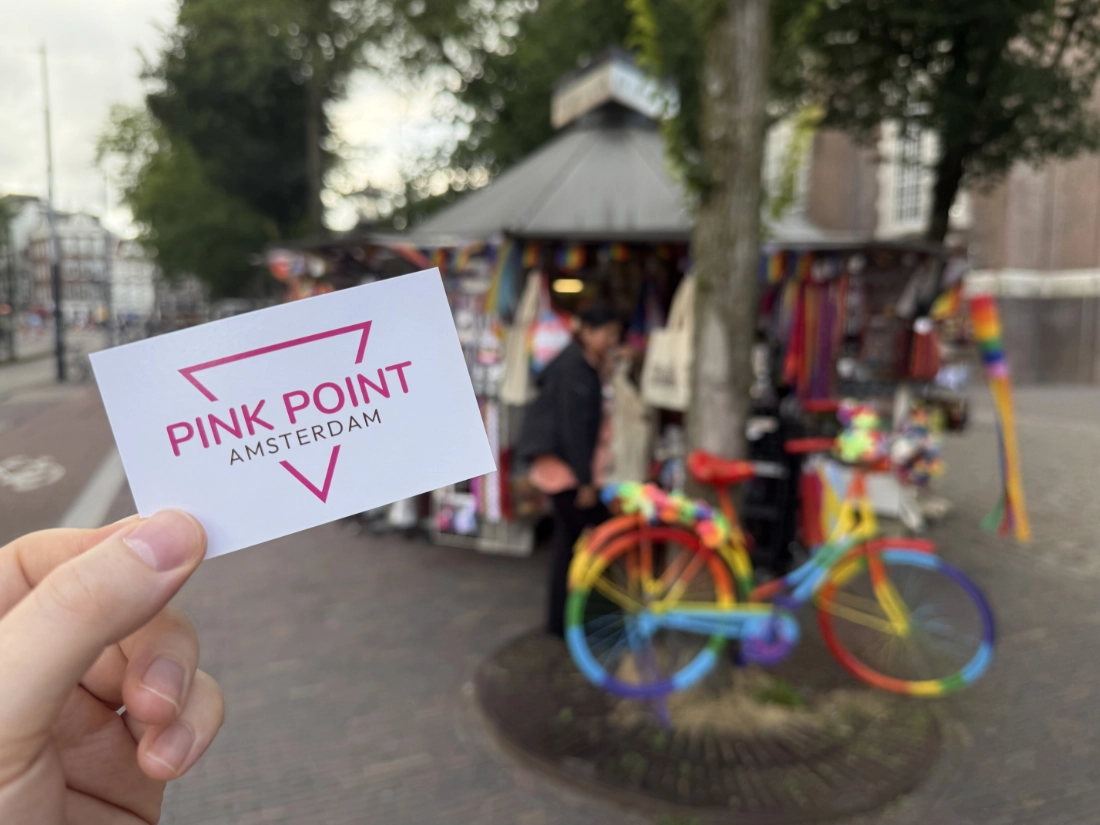

The Symbolism of Westerkerk and Anne Frank
Standing tall next to the Homomonument is the Westerkerk, one of Amsterdam’s most famous Protestant churches. From the annex where Anne Frank hid, she wrote about hearing its bells. The triangle formed by the Westerkerk, Homomonument, and Anne Frank House creates a deeply emotional landscape that embodies memory, loss, and resilience. The proximity of these three sites forms a powerful narrative: one of Jewish persecution, queer oppression, and collective remembrance. The echo of the Westerkerk bells brings history into the present, creating a soundscape of reflection.
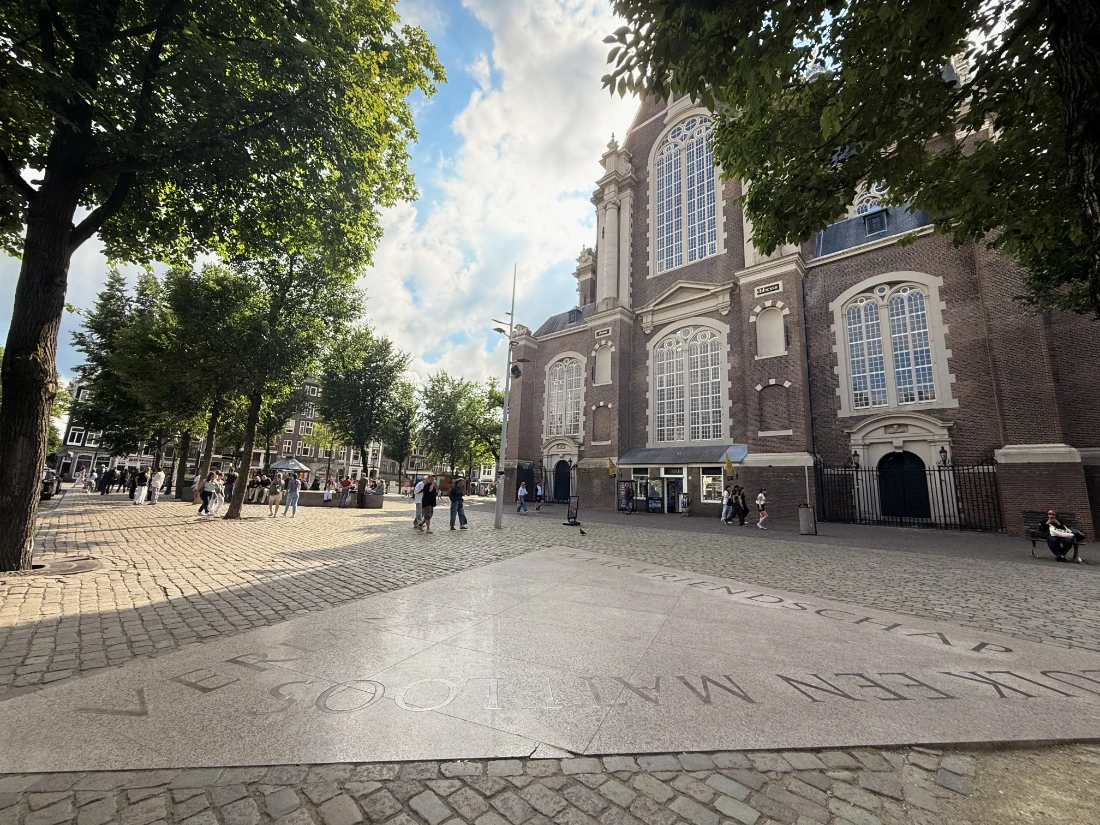
Take a moment to read the inscription on the granite: “Naar Vriendschap Zulk een Mateloos Verlangen”, which translates to “Such a boundless craving for friendship” in English.
For many visitors, especially those who identify with multiple marginalized identities, this space is both symbolic and sacred. We often find ourselves pausing here, taking in the magnitude of what it means to be free, visible, and alive. In this space, remembrance and activism merge, reminding us that the fight for justice is ongoing and that we owe a great debt to those who came before us and fought for their rights and ours.

Annual events at the Homomonument
The Homomonument is a living space where memory and action coexist. Throughout the year, it hosts events that bring together the LGBTQ+ community, allies, and visitors to honor lives lost and to celebrate queer resilience. On May 4, the Netherlands observes National Remembrance Day with a solemn ceremony. Here at the Homomonument, LGBTQ+ victims of World War II and ongoing persecution are remembered through speeches, the laying of wreaths, and a moment of silence. The very next day, May 5, Liberation Day marks the transition from mourning to celebration. This shift in tone reflects the dual purpose of the Homomonument — to grieve and to rejoice. During the weeks before Amsterdam Pride, the monument is part of the Pride Walk and other inclusive events like the Drag Olympics. On November 20, the Transgender Day of Remembrance is held here, reminding us of the lives lost to anti-trans violence and the importance of ongoing advocacy and community support.

Key events at the Homomonument in an overview:
- May 4: National Remembrance Day: Memorial for LGBTQ+ victims of World War II and ongoing persecution. The Homomonument hosts an official ceremony with wreath-laying and two minutes’ silence for LGBTQ+ Holocaust victims and those persecuted today.
- May 5: Liberation Day: Liberation Day is celebrated with lively community events, often including dance performances and concerts.
- Amsterdam Pride (July): organizing queer events before Pride Amsterdam, including the Pride Walk and additional community gatherings.
- November 20: Transgender Day of Remembrance: Candlelit vigil for trans lives lost
- Year-round: a place for remembrance and queer solidarity
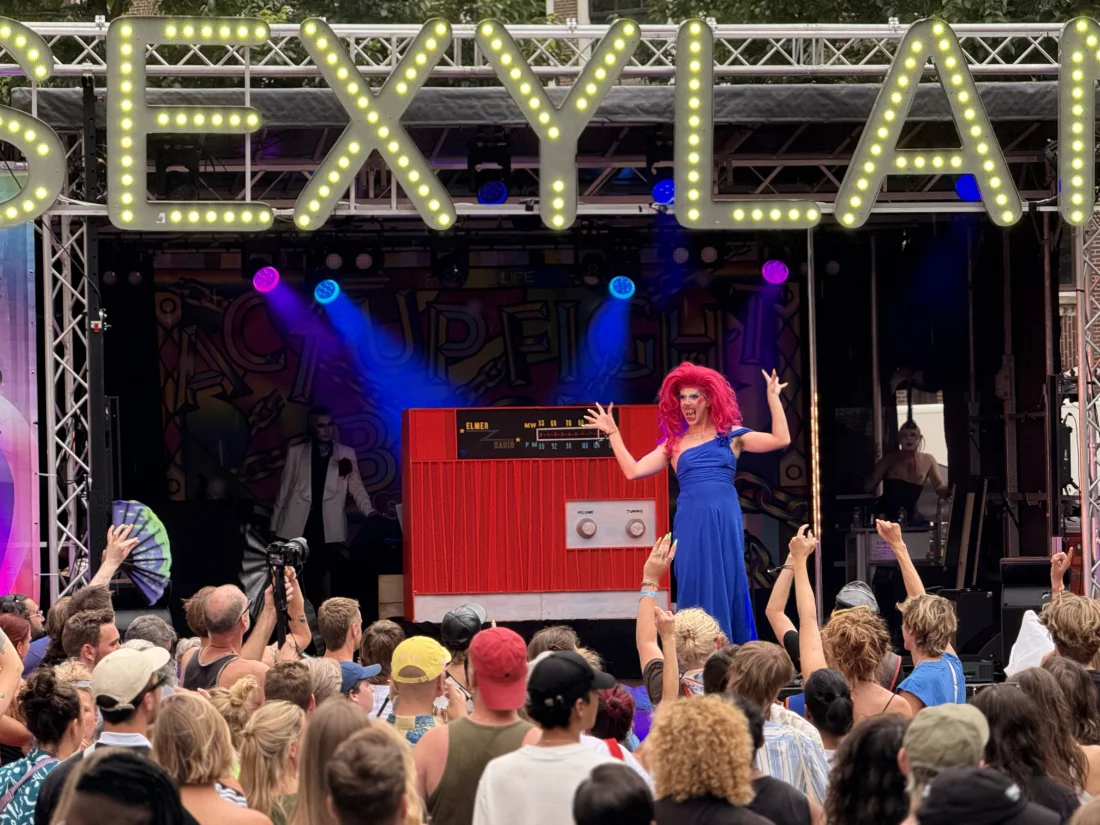
How to visit Pink Point and the Homomonument in Amsterdam
Planning a visit to Pink Point and the Homomonument is easy, and it’s one of the most meaningful stops you can make in Amsterdam. Located at Westermarkt 1016 DK, the site is centrally located and easily accessible on foot or by public transportation. Trams 13 and 17 stop at Westermarkt, and it’s just a 10- to 15-minute walk from Central Station.
Pink Point is generally open from 10:00 a.m. to 6:00 p.m. daily, although hours may vary seasonally. We recommend visiting in the afternoon or at sunset for a peaceful and reflective experience. The area is typically busy with both tourists and locals, especially during Pride events and memorial days.
While the Homomonument as an open-air monument is open 24/7 all year round, please remember that it is a place of remembrance and respect. Respect is essential, especially during organized ceremonies. Whether you come to reflect, to shop at Pink Point, or to sit and take it all in, this space offers a quiet, powerful affirmation of queer life and history in the heart of Amsterdam.
Reading tip: Learn more about LGBTQ+ monuments and queer memorials worldwide

LGBTQ+ travel tips: making the most of your visit
Amsterdam is one of Europe’s most LGBTQ+-friendly cities, and a visit to the Homomonument and Pink Point is a must for queer travelers. Begin your experience by stopping at Pink Point to pick up free maps and speak with the volunteers about current events, safety tips, and local LGBTQ+ resources. The Jordaan and Oud-West neighborhoods nearby offer various queer-welcoming cafes, shops, and cultural spots. Don’t miss the chance to visit the Anne Frank House, which offers powerful insights into the broader history of persecution. Throughout your visit, keep in mind that this is a space for both celebration and remembrance. Respect the sacredness of the Homomonument, especially if others are gathering for reflection or ceremony. If you’re in town during a Pride event or memorial, plan to participate and witness the living nature of this historic site.
WorldPride Amsterdam 2026: Plan your trip now
Amsterdam will become the global capital of the rainbow LGBTQ+ movement. This guide helps you plan your queer-friendly trip: where to stay, what to do, and how to connect with the global LGBTQ+ community.
Inside Pink Point Amsterdam: Interview with owner Stefaan van der Sleen
As part of our WorldPride 2026 coverage, we sat down with Stefaan van der Sleen, the owner of Pink Point Amsterdam – LGBTQ+ Info & Gifts. What started as a modest information cart during weekends has grown into one of the world’s most visible queer information points, located next to the Homomonument in the heart of Amsterdam. Stefaan shared with us his deeply personal journey, the evolving role of Pink Point, and why this place still matters today more than ever.
Can you tell us how Pink Point began — and how you got involved?
Stefaan: The story of Pink Point Amsterdam started as a mobile cart information center, the Pink Point of Presence, in 1998 for the Gay Games. It was then brought out on weekends so that LGBTQ+ travelers could ask questions about the Homomonument in Amsterdam, which was, back then, the first and only queer monument. Eventually, a sea container replaced the cart in 1999, until the nine-sided Pink Point kiosk we know today. It was designed by Marianne Meinema and officially revealed in 2003. The original idea came, among others, from Richard Kaldoulis – also known as the drag queen Jennifer Hopelezz – who worked with other volunteers to set it up. After a friend who owned it before me passed away, I stepped in and obtained permission from the city of Amsterdam to take it over. So I became the third owner of Pink Point in 2018. I feel lucky and proud to be in this position.
Why was the Homomonument built in Amsterdam?
Stefaan: Interesting question that needs a little historical detour. Every year on Dam Square, the National Monument hosts the National Remembrance Day (Dodenherdenking), attended by the King, the Queen, the Parliament, and others, who come to remember the dark period of history for the Dutch people. For a long time, gays and the rest of the queer community were not explicitly recognized as a group of victims of the Nazis, although gay individuals were deported, imprisoned, and killed in Nazi Germany. There has even been an exemplary incident on May 4, 1970, when gay men were sent away, pushed away really, from remembering when they wanted to lay down a wreath to remember queer history. That was the moment when the idea was born to create a place of our own, a go-to place for the LGBTQ+ community to remember those who came and died before us.
How do you explain the meaning of the monument to people visiting for the first time?
Stefaan: People often ask, “Where’s the statue?” But there is no statue. It’s been designed this way so it is not “in your face.” It’s just there. And we call it a living monument because it’s just part of the city, like our community, the queer community, is and should be. The Homomonument is designed of three pink granite triangles forming a larger triangle. This specific shape refers to a symbol from the Nazis. When homosexual individuals were deported to the concentration camps and killed in the Third Reich, they were made to wear a pink triangle on their chest and their trousers so that they were recognizable as gay individuals in the camps. However, the three granite triangles are positioned in a certain way. One is hovering above the canal and pointing to Dam Square, representing the present. The second one points to the Anne Frank House, representing the past, as we must never forget what happened in the early 20th century. And there is the one closest to the Pink Point that points to the Rozenstraat, where there used to be the head office of the COC, the supporting organization for gay rights. As all three triangles are interconnected, so you would see a giant triangle from above.
What’s the most common question people ask at Pink Point?
Stefaan: Believe it or not, it’s “Where is the Anne Frank House?” Besides that and more about what I do, it’s the question, “What big events are happening tonight?” People still think that Amsterdam is a mega-event city. Well, I mean, we are in a way, but not every day of the week. We don’t have events every day in Amsterdam. But that’s the most common question. But often that’s just a way to start a conversation. So I get out the map, ask where they want to go, and we start talking. Especially now, during Pride, people also bring in flyers, ask about events, and share their experiences. We have a whole wall of queer event info, maps, and community materials.
Have you had moments at Pink Point that really touched you?
Stefaan: Yes, many. One moment that always moves me is when parents come in with their children. The kids don’t always understand what’s happening, but the parents want them to see that it’s okay to be different. That really touches me. And then there are visitors from countries where being queer is dangerous, forbidden, and illegal. They ask, “Can I walk hand in hand with my partner in Amsterdam?” And I say, “In central Amsterdam, yes — watch your back, but mostly, you’re okay.” Hearing their stories and feeling their need for safety always leaves an impression. But it also makes me proud that I live in Amsterdam.
What information and merchandise do you offer at Pink Point Amsterdam?
Stefaan: At the beginning of the Pink Point, they had only a few things, especially pamphlets, and such. Well, it was more about sharing information and chatting with visitors. It was called Pink Point of Presence. Now, as we are in the middle of Pride Amsterdam, with many activities happening, this is a very popular spot for all LGBTQ+ individuals in Amsterdam at this time. Some people bring stuff over, like flyers and posters, and try to promote as much as possible. And that fits, of course, to the purpose of Pink Point. Besides a wall with the most recent flyers and everything event- and queer-related, I offer a diverse range of rainbow merchandise items, from postcards to magnets, queer porcelain figurines, and all sorts of Pride flags. But one of my most popular items, the top seller, is the big rainbow willy. People love it, even as a pillow for their flight home!
Why do you believe Pink Point is still relevant today?
Stefaan: Although the LGBTQ+ community reclaimed the symbol of the pink triangle, we need to remember the past. Today, more than ever, education, facts, and information remain essential. And we need a queer visible community as well as safe spaces. I also see that the whole world has changed, and alliances have shifted. Specifically, it feels like people are more likely to go against LGBTQ+ rights. And that’s what I also noticed here. People passing by, calling me names. It happens more often than before. But the Pink Point Amsterdam and the Homomonument are meant to be part of the city, just like our [queer] community. It’s a living monument — used for protesting, singing, dancing, and celebrating LGBTQ+ culture. On busy event days, I’m usually fenced in, but Pink Point is part of it all. I lend a hand, provide electricity, and answer questions. That’s what it means to me when I talk about a living monument. I work for the community, with the community, and in the community. Every day, except for one day off, I’m here. The work matters.
Dear Stefaan, thank you so much for your time, your stories, and for sharing your insights about this vital part of the LGBTQ+ history of Amsterdam.
The interview is part of our blog series on Couple of Men, introducing LGBTQ+ owned businesses, especially those operated or owned by queer couples like us. Read more about our campaign here!
Daan & Karl.
This interview has been lightly edited for length and clarity.
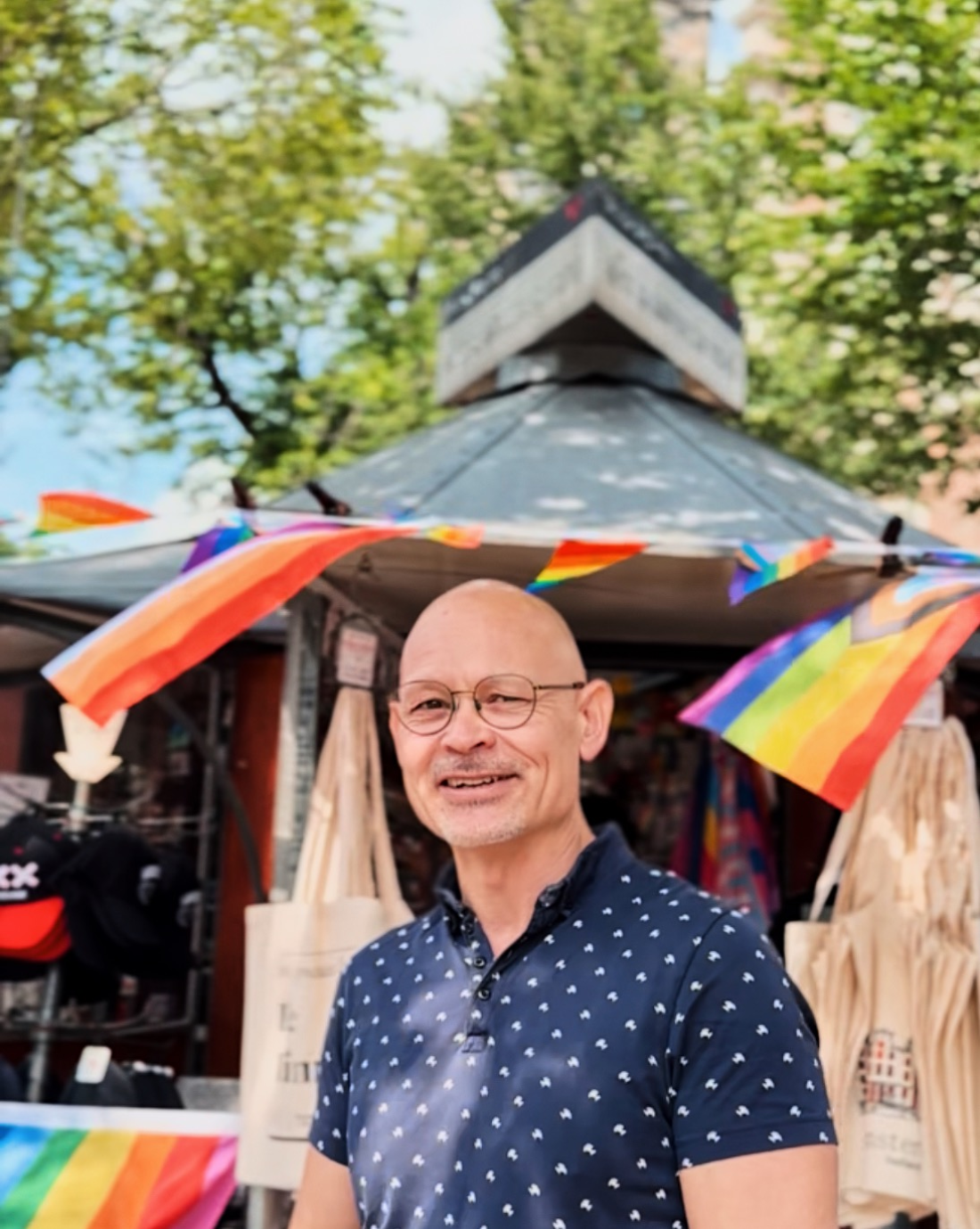
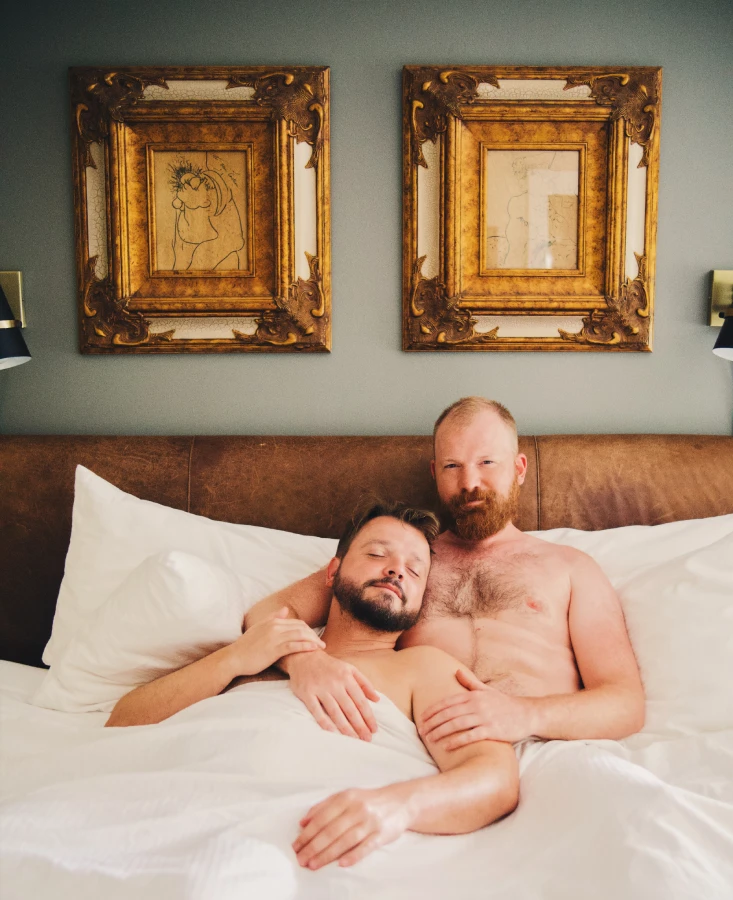
Gay Travel Index 2025
The Berlin-based Spartacus informs LGBTQ+ and queer travelers about how gay-friendly a holiday destination is according to several ranking factors and criteria.
Which country ranks first? Where is it safe to travel to as a gay and LGBTQ+ traveler?
You can use the GTI to prepare for your gaycation and as a guide when choosing a holiday destination.
LGBTQ+ welcoming accommodations near Homomonument
While most hotels in Amsterdam are LGBTQ+ friendly, you can make your choice even easier by checking the Travel Proud Properties on Booking.com. Hotels that have the ‘Travel Proud’ badge have completed the training to offer a more profound understanding and welcome service to their LGBTQ+ guests. Look for the badge (Travel Proud rainbow suitcase) right above the name of the hotel. These three hotels are Travel Proud Properties and are located near the Homomonument and Pink Point.
W Amsterdam ★★★★★
Located just behind Dam Square, Travel Proud Property W Amsterdam blends historic architecture with a sleek, modern interior. Known globally for its LGBTQ+ inclusivity, the W Amsterdam hosts fabulous rooftop parties and participates in the Canal Parade with its own float. Read more >
Andaz Amsterdam Prinsengracht ★★★★★
Situated alongside one of our most beautiful canals, Travel Proud Property Andaz Amsterdam Prinsengracht has a playful interior décor that celebrates Dutch heritage and the unique flavors of our charming city. Get that extra luxury during Pride Amsterdam and watch the Canal Parade pass by your hotel room window. Read more >
Hotel Mercier ★★★★
Once home to the headquarters of COC (the world’s oldest LGBTQ+ organization), Travel Proud Property Hotel Mercier is a stylish hotel with character and a high-end vegan restaurant. It’s your home away from home during Pride. Don’t miss “Dans Volk”, a queer photography exhibition on view throughout the common areas. Read more >

Why Pink Point & Homomonument matter: then, now, and for WorldPride 2026
For us, the Homomonument isn’t just a landmark — it’s a reminder. Of those who came before. Of why Pride matters. Of how far we’ve come and how much further we have to go.
Whether you’re visiting Amsterdam for the first time or returning for WorldPride 2026, make time for this space.
Stop by Pink Point. Stand at the triangle. Let the bells of the Westerkerk ring in your ears, and let the queer history move through you.
Do you like it? Pin it!
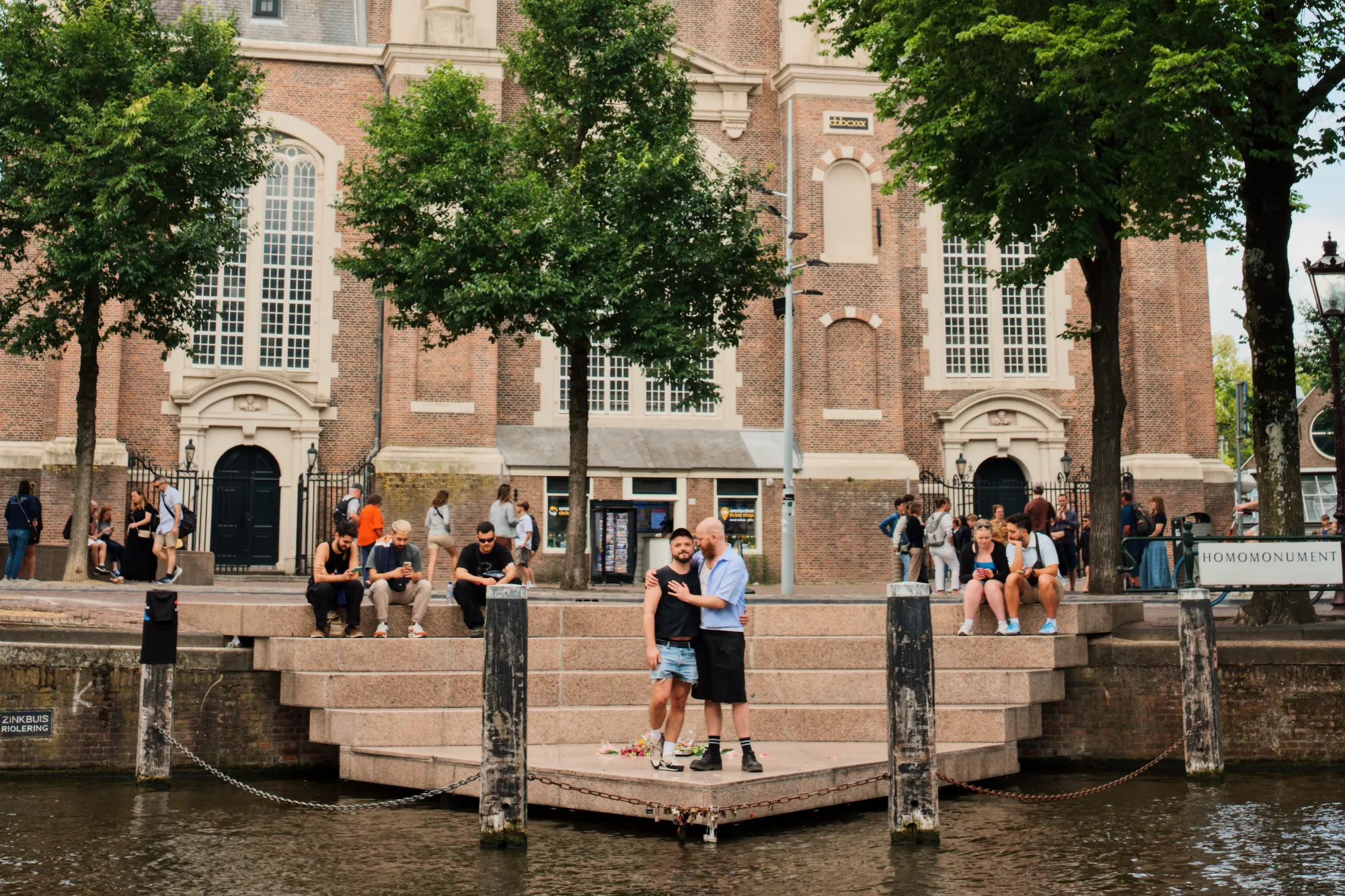
Do you want to know more about travel news from the LGBTQ + community? Follow us on Instagram, Threads, TikTok, YouTube, and Facebook! See you at Pride in Amsterdam or somewhere in this beautiful, diverse, and eclectic world!
Travel Proud with Couple of Men & Booking.com
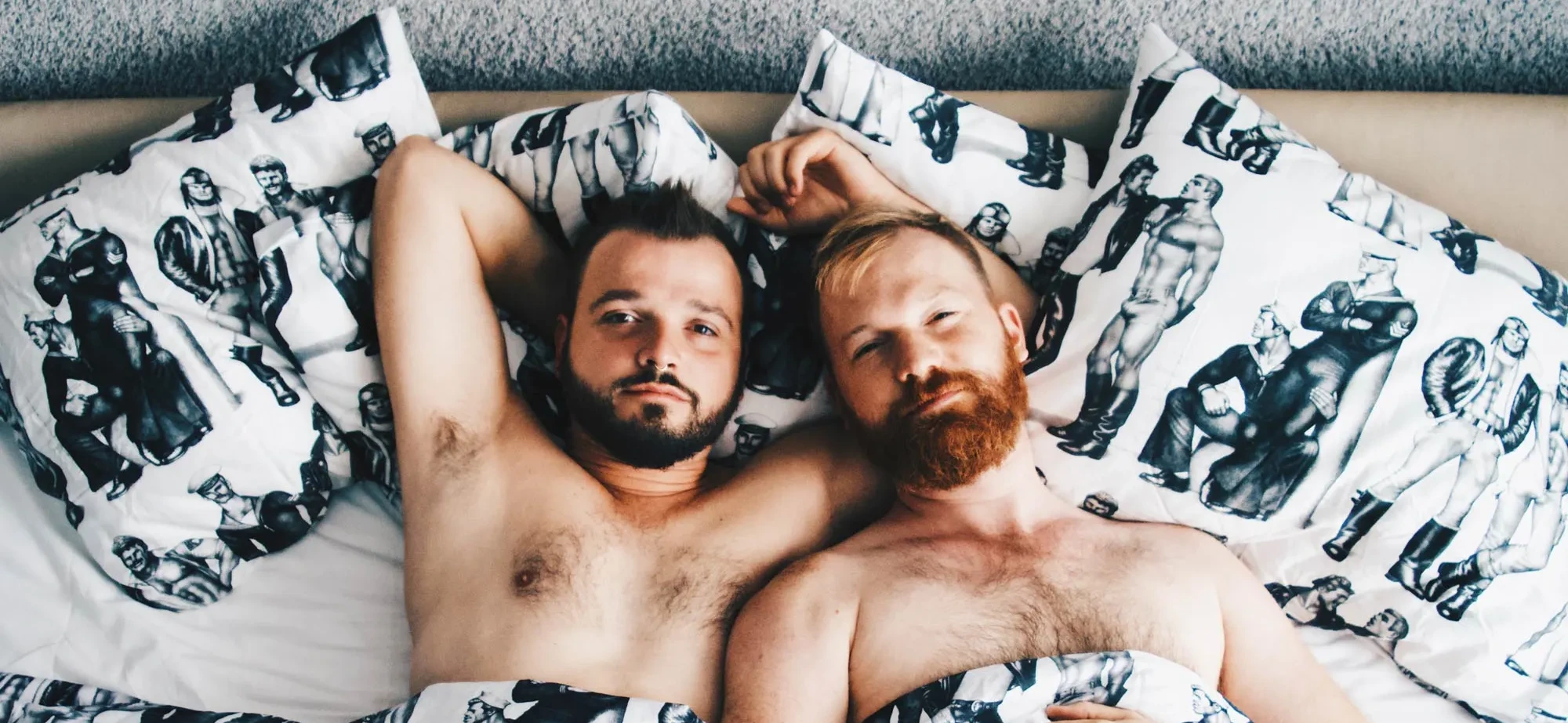
We filter destinations, not people.
As queer travelers using Booking.com’s Travel Proud Porperties ourselves, we are proud to support their LGBTQ+ inclusive travel experiences around the world. More than half of LGBTQ+ travelers have experienced discrimination while traveling – and that needs to change. That’s why Booking.com created the Travel Proud program: to help accommodations understand the unique challenges queer travelers face, and to ensure warm, welcoming stays – wherever we go.


